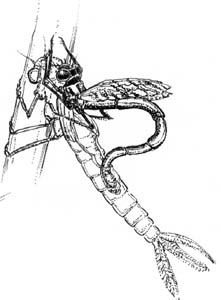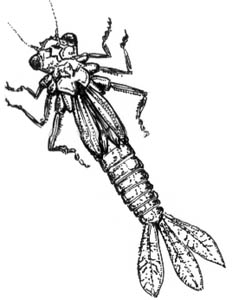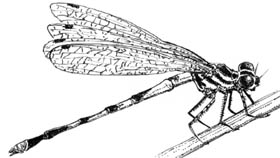Damselflies
Order: Odonata, suborder Zygoptera
Genus: Enallagma
Indentifying
Features
Nymphs: Easily identified by their long, slender bodies
and sculling, side- to-side movement, they have three prominent tails,
actually fan-like gills, and large, wide-set eyes. Dark olive is a common
color, but color changes depending on habitat: brown in off-color lakes,
for example.
Adults:
Perhaps best known by their slim blue bodies they are more slender
than the dragonfly, and the damselfly's large double set of wings is
folded over the body when at rest, unlike the outstretched wings of
the dragonfly at rest.
What
to Look For
Emerging nymphs must crawl out of the water to become adults. Watch
for them crawling up shoreline reeds or even anchor lines and the boat
itself. Splashy near-shore rises are a good warning that damselflies
are emerging. Also watch for split nymphal shucks clinging to shoreline
reeds or debris.
 |
|
|
Life
Cycle
Nymphs develop over a period ranging from a few months to one year,
going through several molts or instars during that time and growing
larger with each. They remain hidden in dense weed growth throughout
this development. Length at time of emergence is usually about four
cm. When fully developed the nymphs look for something to crawl out
on, often shoreline reeds. The shoreward swim takes place near the surface,
with nymphs first rising towards the surface then levelling off. Once
out of the water and clinging to reeds, the nymph waits to dry; the
skin splits and the adult emerges. After the wings unfold and dry, adults
take to the air. Females deposit their eggs in the lake. Spent or dead
damselflies are rarely taken by fish.
When
to Fish
Early June is the peak emergence time for many Kamloops lakes, normally
lasting for a period of about two weeks. Watch weather conditions: a
late-arriving spring delays the emergence, etc. Altitude also plays
its usual role; higher lakes are somewhat later than more low-lying
lakes. Nymph imitations fished deep over dense weeds can provide fast
action for some time before emergence begins.
How
to Fish
During the shoreward emergence swim of the nymphs, it is accepted angling
practice to anchor within casting distance of shoreside reeds; dry lines
are most often used with sinking patterns, allowing the fly to be retrieved
just below the surface. Patterns with large, bulging eyes simulate the
side-to-side
swimming
motion of the naturals when the line is hand-twisted.
Fishing
Tip
The just-below-surface swim of the emergers highlights them for trout
looking up from below. This brings a swift and often savage response
even from more cautious older fish: do not set hooks hard as the weight
of larger fish will instantly pop tippets light enough to give the fly
life.
Any indication
of large numbers of flying adults should send anglers shoreward for
signs of emerging nymphs.
Be sure
to visit Fishbc.com for angling information!
Back to introduction

















